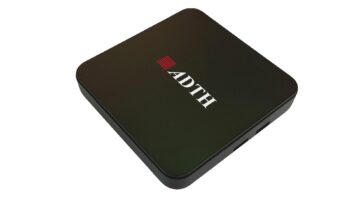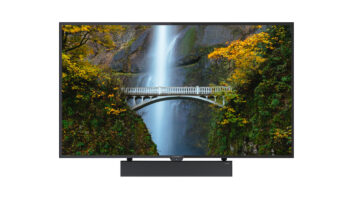One of the highlights of this week’s CES will be the virtual explosion in the number of flat-panel television SKUs, including many new screen sizes, coming from a horde of new vendors signing on “with the technology of the future.”
At the show, new record screen sizes will be announced for plasma and LCD TVs, with LG/Zenith unveiling what is expected to be the largest plasma panel at 76W-inches. Both LG and Philips, which is a partner in the LG.Philips LCD factory in Korea, are also expected to announce a 55W-inch LCD-TV screen size at the show.
In addition to size, the new larger panels promise superior picture performance. Both the plasma and LCD panels will also produce a native pixel resolution of 1,920 by 1,080 progressive — the highest resolution in the current DTV lexicon.
Close behind will be Samsung and Sharp, which both planned to unveil new company records in LCD-TV screen sizes of 46W- and 45W-inches, respectively.
Sharp, which soon will be producing very large LCD panels from its new Kameyama, Japan facility, is in the process of shifting its entire TV production and marketing focus to LCD technology, while dropping plasma panels and eventually CRT tubes (starting in Japan next year) from its assortment.
Bob Scaglione, Sharp Consumer Electronics Group marketing VP, said his company will push LCD as a superior flat-panel technology, offering greater longevity, both in lamp life and pixel life, while offering better contrast performance than most plasma displays.
“With [Sharp’s] new 45W-inch screen size, we expect the consumer to start the migration from plasma to LCD once they start making the comparisons on the floor,” Scaglione said. “Then, by 2005, we expect price points to make LCD even more competitive vs. plasma offerings.”
LG Electronics president T.J. Lee said his company sees “pros and cons for both technologies,” and expects to enjoy a long, viable market from both businesses.
Plasma displays still yield a larger screen size, and offer higher brightness levels while color and overall performance improve every year. Lee acknowledged that huge strides have been made in the development of LCD technology and that over time, prices and screen sizes will come closer together, which led LG to make substantial investments in the development of both flat-panel approaches.
Matt Dever, Pioneer marketing and product planning VP, said that over the next five years Pioneer believes plasma displays will continue to hold advantages over LCD TVs, particular in price. He said Pioneer expects the economies of scale in LCD manufacturing to keep pricing higher than plasma in larger screen sizes until the next class of flat-panel technologies such as Organic Electro Luminescent (OEL) displays begin to take hold.
In addition, LCD TVs, he said, have some inherent disadvantages to plasma, such as a color-shift condition that results when looking at a screen from different angles.
Pioneer expects the two technologies to continue to dominate sales in different screen size segments for the next five years. LCD TVs, he said, will be the display of choice in screen sizes under 40-inches, while plasma will continue to represent the majority of sales in screen-sizes larger than 40-inches.
Like Sharp, Pioneer continues to evaluate its long-term participation in CRT-based products. Dever said the growth in flat-panel sales is gradually eating into the higher-end rear-projection business, while rear-projection televisions based on micro-device engines, such as DLP and LCoS, are making in-roads on the older technology. Currently, Pioneer has no plans for micro-device-based displays, he added.
Pioneer, for now, continues to carry rear-projection HDTV monitors as a niche player, but will evaluate later in the year its CRT path for 2005, when the Federal Communications Commission’s phased-in DTV tuner mandate begins.
Although growth rates are accelerating for both flat-panel technologies, market research firm iSuppli/Stanford Resources still sees a substantial business for traditional CRT products over the next several years.
CRTs will maintain the market lead due to their dramatically lower cost, said Riddhi Patel, iSuppli senior analyst. However, CRTs will lose share to other technologies like LCDs and plasma displays at the high end.
LCDs will account for only 14 percent of total television unit shipments by 2007, Patel said. In contrast, CRT TVs still will dominate unit shipments in 2007, with an 80 percent share of the market, down from 94 percent in 2003, Patel predicted.
According to Patel, the total worldwide direct-view LCD-TV market will expand to about 27.5 million units in 2007, rising at a compound annual growth rate (CAGR) of 70 percent from 3.4 million units in 2003.
In North America, LCD-TV sales are expected to climb from 488,000 units in 2003 to 1.48 million units in 2004, and on to nearly 7.9 million in 2007. Average LCD-TV pricing, according to iSuppli, will decline from $1,418 today to $1,071 in 2004 and down to $741 in 2007.
In that period, the largest selling screen size in North American LCD TV sales will shift one step larger each year until 2007, when the 26-inch to 30-inch segment will remain the largest selling sector for a second straight year at 4 million units. The 11-inch to 15-inch segment is expected to represent the largest segment of sales in 2003 at 237,000 units, moving to 16-inch to 20-inch at 637,000 units in 2004, according to iSuppli.
Meanwhile, the North American market for plasma televisions was projected to end 2003 at 231,000 units, climbing to 533,000 in 2004. By 2007, the market is expected to reach 3.1 million units, according to iSuppli data. The average selling price for a plasma TV is estimated at $5,091 today, dropping to $3,704 in 2004, and plummeting to $1,659 in 2007, iSuppli said.
In terms of plasma sales by screen size, the 40- to 44-inch segment will represent the largest selling sector for the next four years, iSuppli said. Approximately 116,000 40-inch to 44-inch plasma displays were sold in the North American home-theater market in 2003, iSuppli estimated, with that number growing to 244,00 in 2004 and 1.25 million in 2007. Also in 2007, the 50-inch to 59-inch segment is expected to make significant gains, growing to 1.1 million units.
One of the more noteworthy trends at the 2004 CES is the number of new vendors jumping into the flat-panel business, some under some familiar labels.
LCD TVs and/or plasma panels are now offered under the Westinghouse, Motorola and Lafayette names, all of which are having products manufactured for them in either China or Taiwan. All offer a value-added marketing message and will compete with the established CE powers.
At the same time, IT retailer Gateway is moving into the flat-panel business with a price/volume strategy that is jump starting its sputtering IT business.
It is also pushing established players, who are still seeking to make a return on their development investment, more and more to the higher-end of the market.













